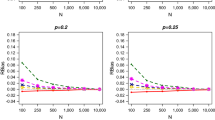Summary
In the present paper we shall get an estimate, by using a multiple recapture method, of the total size of a population which consists of several classes, and consider some asymptotic properties of the estimate.
Similar content being viewed by others
Abbreviations
- N :
-
the total number of individuals in the population (unknown)
- s :
-
the number of classes (assumed to be known)
- N (r) :
-
the number of individuals inrth class (r=1, 2,⋯,s) (unknown)
- T :
-
the number of samples taken
- p (r) j :
-
the probability that any individual inrth class is caught injth sample (r=1, 2, ⋯,s;j=1,⋯,T) (unknown)
- \(n_{j_1 ...j_t } \) :
-
the number of individuals that are caught in thej1th,j2th,⋯, andj t th samples (observable)
- \(n_{j_1 ...j_t }^{(r)} \) :
-
the number of individuals inrth class that are caught in thej1th,j2th,⋯, andj t th samples (unobservable)
References
D. G. Chapman and C. O. Junge, Jr., “The estimation of the size of a stratified animal population”,Ann. Math. Stat., Vol. 27 (1956), pp. 375–389.
S. A. Stouffer and others,Measurement and prediction, Studies in Psychology in World War II, Vol. 4, Princeton University Press, 1950, pp. 362–472.
Author information
Authors and Affiliations
About this article
Cite this article
Takahasi, K. Model for the estimation of the size of a population by using capture-recapture method. Ann Inst Stat Math 12, 237–248 (1961). https://doi.org/10.1007/BF01728933
Received:
Published:
Issue Date:
DOI: https://doi.org/10.1007/BF01728933




